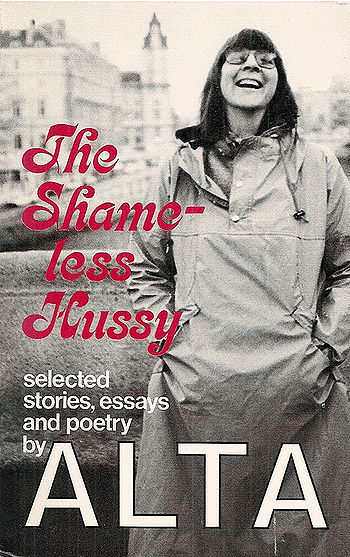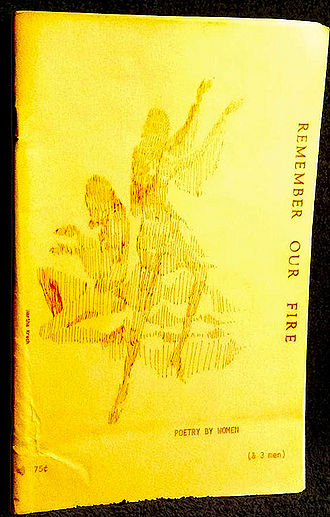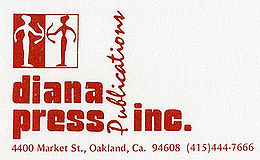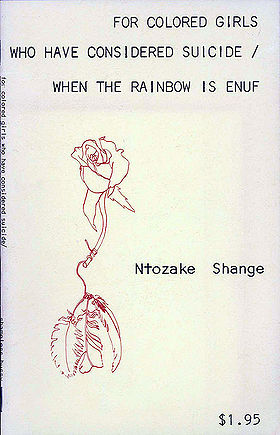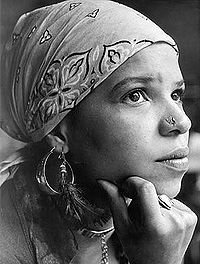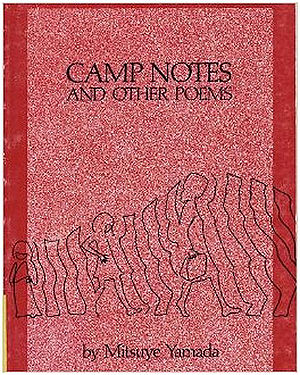Shameless Hussy Press, 1969-1989
Historical Essay
by Lauren Kivlen, 2015
| Shameless Hussy Press was founded by Alta Gerrey in Oakland in 1969 and was the first feminist press in the United States. Shameless Hussy is responsible for publishing over fifty titles including the first books by four women who would later become internationally prominent feminist writers: Pat Parker, Mitsuye Yamada, Ntozake Shange, and Susan Griffin. |
Shameless Hussy
i am one of the true hussies;
i have no shame;
i was a housewife, and
stretched from the housiness of it (hus)
and the wifiness of (wif/hus-wif) to
a woman who cant bear wifedom (hussy) / i
grew beyond the house, like alice after eating
too many cookies. exactly what i did; i ate
too many cookies; lovers, poetry, moving my
body in a new way, an old way, the way women
like me have always moved, largely; with great
motions beyond our allotted sphere, with more
need than fear, and more grace than shame.[1]
—By Alta
A new kind of literary scene began to take shape in San Francisco during the 1950s and 1960s. These decades marked an era in which poetry came to the streets, and poets like Allen Ginsberg and Bob Kaufman could be found prophetically reciting their poems from soapboxes on Grant Avenue. The voices of these and other poets resonated throughout the city in pop up coffeehouses and pocket-sized poetry book series. Graham Mackintosh at White Rabbit Press and David Hazelwood of Auerhahn Books had great success publishing works by Jack Spicer, Michael McClure, Philip Lamantia and others.[2] Writers were driven by a desire to break with literary and social rules, expanding the boundaries of what could be said and how it could be said. Despite the revolutionary character of these transgressive writings, they reproduced a radical literary scene that was dominated by white middle-class males. Not for long. A Nevada-born single-mom was about to transform this scene forever.
With the burgeoning second-wave of feminism close behind her, Alta Gerrey (aka Alta), founded the first feminist press in the United States: Shameless Hussy Press. She says, “I started the first feminist press in [the second] wave of feminism in America. At that time, 94% of the books printed in the US were written by men. I called the press Shameless Hussy because my mother used that term for women she didn’t approve of, and no one approved of what I was doing.”[3] Founding the first feminist press in the U.S. was no easy task. Alta ran the press for 20 years in the midst of death threats and persistent sexism. Through the hardships, Shameless Hussy Press managed to make significant contributions to the history of women’s literature. Shameless Hussy is responsible for publishing over fifty titles including the first books by four women who would later become prominent, internationally known feminist writers: Pat Parker, Mitsuye Yamada, Ntozake Shange, and Susan Griffin.
Alta was born in 1942 in Reno, Nevada. In 1954, her family moved to Berkeley so that her brother could attend the California School for the Blind. She attended UC Berkeley in the early 1960s, but dropped out to teach in Virginia where protests over segregation / integration had led to the closure of public schools. In an interview about the experience, she said, “Obviously they didn’t need some white chick from California. I found out my job was to fight racism in my own community among whites.”[4] Upon her return to California a few months later, she began to question the institution of marriage and explored this in her early writing. In 1970, her second marriage to poet, John Oliver Simon, ended in divorce. By this time, Alta had moved to Oakland where she organized a commune that provided refuge for women escaping abusive marriages; it was here that Shameless Hussy Press was born. Like many independent and leftist presses at that time, Shameless Hussy operated on a shoestring while Alta, a single mother, scraped by on welfare.
By the late 60s, feminist writing communities were beginning to take shape around the country in what were called, “small group meetings.” Alta says,
“One of my neighbors had one; a woman named Leonore invited six of us over for dinner one night; and another woman named Marilyn invited a few people over for afternoon tea. We started reading that there were women’s groups getting together and we realized that’s what we’d been doing at Susan Griffin’s house.”[5]
Alta, Susan Griffin, Pat Parker and others in the group had all been writing for years, but none of them could get published. She remembers,
“I couldn’t get published except by my ex-husband. Susie [Susan] Griffin couldn’t get published. I knew she was a great poet. Pat Parker couldn’t get published and I knew she was a great poet. I’d lived with John Oliver Simon for three years, and I saw him publish and print his own books. He had taught me how to print. When I realized that all you had to do was put paper in a printing press and have it come out and fold it, and call it something . . . if you did that for eight pieces of paper, folded them, and called it something, it was a book. So I learned how to make a book. I had been reading Anaïs Nin’s diaries, and I knew that she and Henry Miller had made books on a letterpress. When I found out that the only person who would publish me was my ex-husband, and no one would publish Susie, and no one would publish Pat, I thought, I think I can do this.”[6]
Alta read anything she could get her hands on by women writers. She found ten poems about being a woman and put them all in the first book she printed—an anthology of women’s poetry called Remember Our Fire. She published 250 copies and started taking them to local bookstores, Cody’s Bookstore and Up Haste being the only two bookstores that agreed to sell them. “And a miracle happened,” Alta remembers, “We sold out in six months.”[7] The early success of Shameless Hussy did not come without hardships. Alta received multiple messages threatening to take her life and destroy her press. “When I say I got death threats I’m not kidding,” Alta says. “People threatened to destroy my press, my physical AB Dick 360 offset press.”[8] Alta took the threats very seriously. Not wanting to endanger her press or her daughter, she picked up everything and moved to San Lorenzo. “I had to move to the suburbs and get a post office box and an unlisted phone number, because the kind of people who were making the threats were terrified of the suburbs. They were scared to go out there,” she says.[9] Diana Press, another feminist press founded in Oakland, received similar threats but decided against moving their location.
One night in 1977, the press’s workshop and books were destroyed in a raid led by unknown suspects. They had only published 3 books when they got wiped out. One was a children's coloring book.[10] About two years later, evidence surfaced that it had been a group of women who were responsible for the crime. After the raid, reflecting upon the threats she received, Alta claimed that it was women who were threatening her also.[11] Alta remembers that Mama's Press, also in that area of Oakland, suffered the same destruction in 1973 or 1974.[12]
Despite the opposition, Shameless Hussy Press would publish over fifty books between 1969-1989. During the first five years, using her AB Dick 360 offset press, Alta physically produced all of her books herself--printing, collating, and stapling each one. “Then I physically shlepped them around,” she remembers. “I didn’t have a driver’s license at the time. I physically took them in boxes on the bus, to the two bookstores.”[13] Small press distribution companies were not in existence during this time. Shameless Hussy books were distributed with the help of Alta’s friend, Alma Cremonesi. Alma went to women’s conferences with books while Alta took boxes to American Library Association conferences and American Booksellers Association conferences.[14] Finally, in 1974, Shameless Hussy was featured in a catalog of women’s groups and businesses. By this time, about a dozen women’s bookstores had appeared in the American landscape, and they all ordered Shameless Hussy books.[15]
The last book that Alta printed herself was Ntozake Shange’s, For Colored Girls Who Have Considered Suicide/When the Rainbow is Enuf in 1974. She remembers,
“By this time I had a printing company that I worked with, so I wasn’t doing the books myself. The last book I did myself on my AB Dick 360 out in the garage was Ntozake’s. The reason I did it, because by then I could have hired another printer to do it, was I loved Ntozake’s book so much that I wanted to print it. So For Colored Girls is the last book that I printed.”[16]
Alta’s working relationship with Shange was unexpected. She had met Shange’s sister, Thulani Davis, at a poetry reading in the San Francisco Public Library. Amazed by Davis’s work, she offered her a business card for Shameless Hussy Press. Davis never sent Alta a manuscript, but her sister Shange did.[17] The manuscript, a series of 20 poems called For Colored Girls Who Have Considered Suicide/When the Rainbow is Enuf, told the stories of seven women of color who had been oppressed by racism and sexism.[18]
“somebody/ anybody
sing a black girl's song
bring her out
to know herself
to know you
but sing her rhythms
carin/ struggle/ hard times
sing her song of life
she's been dead so long
closed in silence so long
she doesn't know the sound
of her own voice
her infinite beauty
she's half-notes scattered
without rhythm/ no tune
sing her sighs
sing the song of her possibilities
sing a righteous gospel
let her be born
let her be born
& handled warmly.”[19]
— from Ntozake Shange’s, For Colored Girls Who Have Considered Suicide/When the Rainbow is Enuf
Shortly after being published by Shameless Hussy, the series became a broadway hit in New York as a choreopoem performed with dancing and music.
In addition to Shange’s work, Shameless Hussy also published the first books by three other women who would later become notable feminist writers. “It’s funny how famous some of the authors got,” says Alta. “Susan Griffin got really famous.”[20]
Known to her as “Susie”, Griffin is now considered one of the most influential feminist writers of the 20th century. She and Griffin belonged to the same women’s group in Berkeley. “Susie and I found each other in her kitchen,” Alta remembers.[21] Alta recognized Griffin’s talent and published her first books, The Sink and dear sky. Her poetry aimed to publicize rape as a political act.[22] Alta, Griffin, Judy Grahn and Pat Parker would have long discussions about how political their poetry should be. “We would argue about how political should we make stuff. Should we stick to the personal. Susie kept saying, ‘the personal is political.’”[23] Griffin is now recognized as a prominent eco-feminist writer. Her work draws connections between the destruction of nature and the marginalization of women.[24] Shameless Hussy also published Pat Parker’s first book, Child of Myself in 1971. Parker is recognized as one of the first black lesbian writers in the United States.[25]
She met Alta through Alta’s ex-husband, John Oliver Simon, who had asked both women to be editors for his literary magazine. Alta remembers that Parker used to go to late night porno shows in Oakland as a way to relax:
“She came over to my house and said, Alta, I think there’s a reason I like to watch naked women. I said, yeah, what’s that? She said, I think I like women. I said, well a lot of us like to watch naked women, Pat. She said, no, I mean I really like to watch naked women! So a few months later she wrote a poem about it, brought it to me, and said, Alta, I think I’m a dyke! Do you know any? I said, well Judy Grahn is writing a book called Edward the Dyke. She said, who’s Judy Grahn?”[26]
Soon enough, Parker, Grahn, Griffin and Alta became, as Alta says, “The Big Four.”[27] In addition to knowing the women in “The Big Four,” Parker was also close friends with Audre Lorde. She and Lorde exchanged visits and letters until her death.[28] Parker died of breast cancer in 1989.
In 1976 Alta met English professor, Mitsuye Yamada. Yamada was born to first-generation Japanese immigrants, and spent her early life in Seattle, Washington. In 1942, Yamada and her family were interned at Minidoka War Relocation Center, Idaho.[29] Shortly after meeting Yamada, Shameless Hussy decided to publish her work Camp Notes and Other Poems.
This groundbreaking series expressed the weight of her experience living in a Japanese Internment Camp, capturing the pain she felt at being perceived as an outsider.[30] Alta remembers,
“After Mitsuye Yamada’s Camp Notes came out we learned that it was the first book since 1947 that had been published by a Japanese-American about her experiences in the camps. There had been two books published in the 1940s, and they had both gone out of print.”[31]
It didn’t take long for Camp Notes to become a success. UC Berkeley professor of literature, Bob Yamada, discovered the book at a store in Berkeley and incorporated it into his syllabus. “Once a professor picks it up it’s such a breakthrough,” Alta says.[32]
During the mid-70s, other feminist presses also had a breakthrough. Presses appeared across the nation, as did women’s bookstores, and feminist publications were becoming more widespread. The First National Women in Print Conference had been organized in 1976 by June Arnold and Daughters Publishers, and Feminist Bookstore News came out as a way for women’s presses, authors, bookstores and illustrators to stay in touch.[33] The Bay Area, in particular, transformed greatly with the wave of the women’s movement. A Woman’s Place Bookstore was founded in Oakland, and Carol Seajay started her own women’s bookstore in San Francisco (Old Wives Tales) with a loan from SF’s Feminist Credit Union.[34] In San Francisco women made the Mission Dolores neighborhood theirs. Women created their own cafes (Artemis Cafe), bath houses (Osento), dance bars (Amelia’s), art groups (Mujeres Muralistas) and salons (Garbos — a lesbian-owned haircutting shop).[35]
The climate for feminism and small press distribution had changed dramatically by the mid-80s. Feminist, gay, lesbian and other independent presses and bookstores flourished with the emergence of alternative book distributors, such as the Berkeley-based Bookpeople.[36] Feminist newspapers, journals and magazines were also thriving. “People weren’t threatening my press in the 1980s like they had in the 1970s,” Alta says. “That was a great relief. And there were so many women’s presses. It was like mushrooms. It was wonderful! I didn’t feel as isolated. And libraries were excited about our work. It began to be really clear that the historical movement that we were a part of was not going to be ignored. That was a wonderful thing.”[37]
But by the 1980s, Alta was tired. She had wanted to close the press in the early part of the decade, but chose not to because one of her employees, Jennifer Stone, told her she couldn’t close the press while Reagan was in power. “So I didn’t quit,” remembers Alta. “But the press shows that the last ten years I was tired. The press shows it and the books show it.”[38] Shameless Hussy officially closed in 1989 after twenty years of publishing. The last book Alta published was a series of her own poems called Deluged with Dudes. The book, which was about relationships with men, was released when lesbian separatism was at its height. “People were upset by Deluged with Dudes. I knew they would be,” Alta says. “Shameless Hussy started with Letters to Women, which were love poems to women. And it ended with Deluged with Dudes.”[39]
Shameless Hussy and other early feminist presses played critical roles in the development of early women’s liberation. Art, poetry, and literature shaped the ideology of the movement and made it accessible to women. As feminist, Deborah Gerson, says,
“[Women] weren’t taking a, sort of, Marxist framework or even a black liberation framework, they were creating their own framework. So, there’s a way that all these presses then, we could share and look at it...Alta did it and Judy Grahn’s the She Who poems or The Common Woman poems, those seven portraits, like ‘Oh! This is what women’s liberation is!’...There’s a way that all of this writing really increased the level of understanding of each other and of the collectivity we were calling women in need of liberation, you know. There was a kind of subtlety and specificity to our understanding that couldn’t be gained by just rhetorical or analytical pieces.”[40]
Thanks to Shameless Hussy, the voices of Pat Parker, Susan Griffin, Ntozake Shange, Mistuye Yamada and others have inspired women around the country and the world. Shameless Hussy’s contributions to the history of women’s literature and to the feminist movement have been invaluable. As the history of Shameless Hussy demonstrates, the women’s movement has made great strides toward liberation, but Alta believes that women still have work to do: “Feminism will never be dead as long as women are being beaten by their husbands, or raped, or sold into sexual slavery, or don’t get paid as much as men, or can’t get good health care. We have to have feminism. That’s how we become free people.”[41]
Notes
[1] Alta, The Shameless Hussy: Selected Stories, Essays and Poetry (New York: Crossing Press, 1980), 1
[2] Stephen Vincent, The Poetry Reading: A Contemporary Compendium on Language and Performance (1981), excerpted, Shaping San Francisco’s Digital Archive, (accessed 3 Apr. 2015).
[3] She’s Beautiful When She’s Angry, dir. by Mary Dore
[4] Jennifer Stone, “Alta: Shameless Hussy,” City Miner, (Fall/Winter 1976): 10-11, 42-45.
[5],[6],[7],[8],[9],[11],[13],[14],[15],[16],[17],[20],[21],[23],[25],[26],[27],[31],[32],[36],[37],[38],[39],[41] Alta Gerrey, interviewed by Irene Reti, Alta and The History of Shameless Hussy Press, University Library, UC Santa Cruz, 2001.
[10] David Armstrong, A Trumpet to Arms: Alternative Media in America (Boston: South End Press, 1981), 157
[12] Per email with Alta Gerrey, August 5, 2015.
[18],[19] Ntozake Shange, For Colored Girls Who Have Considered Suicide/When the Rainbow is Enuf (Oakland: Shameless Hussy Press, 1974)
[22] Maggie Humm, Modern Feminisms: Political, Literary, Cultural (New York: Columbia University Press, 1992), 75
[24] Susan Griffin, “Bio,” Susan Griffin, (accessed 28 Mar. 2015)
[28] Alexis De Veaux, Warrior Poet: A Biography of Audre Lorde (New York: W.W. Norton & Company, 2004), 167-169
[29] Mitsuye Yamada, “Biography,” Guide to the Mitsuye Yamada Papers, (acccessed 28 Mar. 2015)
[30] Mitsuye Yamada, Camp Notes and Other Poems (Oakland: Shameless Hussy Press, 1976)
[33],[34],[35] Elizabeth Sullivan, "Historical Essay," Carol Seajay, Old Wives Tales and the Feminist Bookstore Network, Shaping San Francisco’s Digital Archive, (accessed 8 Mar. 2015).
[40] Interview with Deborah Gerson by author, May 7, 2015.

